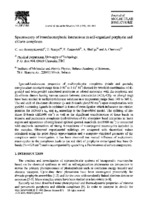Spectroscopy of interchromophoric interactions in self-organized porphyrin and chlorin complexes

Date
1995Bibliographic entry
Spectroscopy of interchromophoric interactions in self-organized porphyrin and chlorin complexes / E. I. Zenkevich [et al.] // Journal of Molecular Structure. – 1995. Vol. 348. – P. 441-444.
Abstract
Spectral-luminescent properties of multimolecular complexes (triads and pentads, complexation constants range from 5∙10⁶ to 5∙10⁷ M⁻¹) formed by two-fold coordination of dipyridyl and tetra-pyridyl substituted porphyrin or related molecules with Zn-porphyrin and Zn-chlorin dimers having various spacers between macrocycles (-CH₂-CH₂- or phenyl ring) have been studied in methylcyclohexane solutions in a temperature range from 140 to 360 K. The red shift of Zn-dimer electronic Q- and B-bands (∆ν≤550 cm⁻¹) upon complexation with pyridyl containing ligands is explained in terms of extra-ligation which influences the relative position for HOMO’s a₁ᵤ, and a₂ᵤ according to the four-orbital model. The splitting of Zn-dimer B-bands (∆E≥600 cm⁻¹) as well as the significant transformation of these bands in trimeric and pentameric complexes (redistribution of the absorption band intensities in Soret region and appearance of complicated splitted spectral manifolds ∆ν≤1900 cm⁻¹) is connected with excitonic interactions of strong B-transitions of π-conjugated macrocycles included in the complex. Observed experimental splittings are compared with theoretical values calculated using the point dipole approximation and a computer-simulated geometry of the complexes under investigation. It has been observed that mutual influence of π-electronic macrocycles in the complexes leads to the red shift of porphyrin extra-ligand free base Q-bands (∆ν≈120 cm⁻¹) and is accompanied by quenching a fluorescence of certain components.
